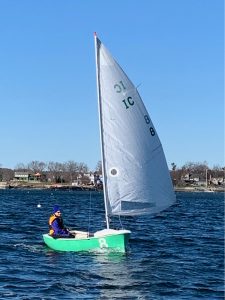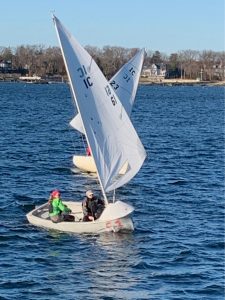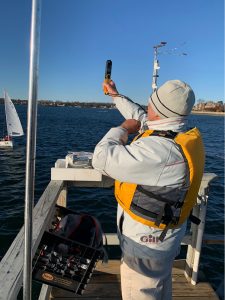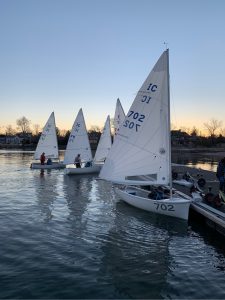Story & photos by Tom Darling

Arthur Knapp, Jr.’s Agony IC #8, recreated in fiberglass
In this second pandemic winter, we rediscover the ultimate socially distanced outdoor recreation for sailors. That would be Frostbiting, or as they say on the Larchmont Yacht Club website, Winter Sailing. Emerging in the depths of the Great Depression, winter dinghy sailing consumed some of the greats of that time, including the inestimable Arthur Knapp, Jr., considered the godfather of winter sailing with his pipe and professorial approach to yachting.
From 1983 to 1996, I participated annually in Larchmont Winter Sailing. In 1992, I was awarded the Little Scorpion Trophy for the most improved sailor. I should have stopped right then and there. My crew got engaged. My daughter was born August 1992 and the duties of fatherhood diminished my skills year by year. When my son arrived, I bagged it and put my 1946-built wooden boat under my sister’s Fairfield County porch.
The lure of seeing the winter sailing scene all again brought me out in December, 2021. The photos for this article reflect the lure of sailing a round-bottomed dinghy in shifty, puffy air above rapidly chilling salt water.
The Creation Myth of Frostbiting according to Arthur Knapp, Jr.
Boating history – I call it Boat Mythology – is particularly rich in the case of frostbiting. Who is better to return to tell that story than one Arthur Knapp, Jr., a Princeton graduate in 1928, the force behind founding intercollegiate sailing in the mid 1920s, and tactician on the J Boat Ranger in 1936. Who else could have snagged a Vanderbilt, J boat owner, to write the foreword to his book when it came out in 1952. That book would be Race Your Boat Right.
How many generations have followed Professor Knapp’s advice in the red-covered classic, with its 334 pages of text, diagrams and photos that I read incessantly as a young sailor? How lucky I was to be gifted a second edition copy from my great uncle, the model builder. That book was acquired, I later learned, at a Larchmont Library sale in the early 1960s.
On the subject of winter sailing, there is no greater authority in print. I suppose I could have just copied the entire text of Chapter XX: “Frostbite Dinghy Racing – A School for Sailing.” It all starts on page 300 of the 1960 edition of Race Your Boat Right. Knapp writes,
“On January 1,1952, Frostbite dinghy racing as we know it today came of age, with the Twenty-First Annual Regatta held by the Frostbite Yacht Club under the auspices of the Manhasset Bay Yacht Club. The Frostbite Yacht Club, an organization unique in the annals of yachting history in that it has “no dues, no assets, no nothing,” has prospered and grown to the extent that 1952 saw it run its first truly formal Regatta.”
He went out to point out, “Its own officers for the past 28 years make up a reasonably fair picture of the outstanding small boat skippers of the eastern seaboard.”
Knapp was never accused of soft-pedaling his hyperbole. He went on to describe the events that coincided with the second edition of the book:
“January 1,1960 saw the 29th Annual Regatta of the Frostbite Yacht Club held on Manhasset Bay, with 112 boats in 4 One-Design Classes…”
“Starting more or less as a joke in the bath-tub gin era of the ‘30s, winter dinghy racing quickly became nicknamed “Frostbiting” and the name has stuck and become synonymous with the sport.
It has been my pleasure and good fortune to have been constantly engaged in dinghy racing on Long Island Sound and elsewhere since that first, wet, cold and snowy New Years Day of 1932 when the first Winter Regatta was founded. And may I say, possibly immodestly, nevertheless proudly, that in 1960 I am the only one left of that original band who raced on the first day who is still actively racing AND IT IS STILL FUN FOR ME.”
Arthur Knapp and frostbiting came to the party together and never left. He waxes poetic on its virtues:
“It is my opinion that anyone who frostbites regularly is attending one of the finest schools in boat handling ever organized, and that includes boats of all sizes…In most cases, your ardent frostbiter doesn’t realize he is attending school. He is out for fun and fresh air, to try his skill against the next fellow, to experiment with a new gadget or new idea, for the thrill of feeling a lively and tricky boat under him in a fresh breeze, and occasionally, for a dunking in very cold and very wet water. But, whether the sailor realizes it or not, every time he starts a race he is learning.”
The word according to Arthur Knapp, Jr. goes for another eight pages, with the professor covering every subject from the choice of winter haberdashery to course configuration. It is indeed the Little Red Book of Frostbiting. There are some priceless sections. Here’s what he said about clothing and the obvious laysailors’s question about the sanity of it all:
“Isn’t dinghy racing cold? Don’t you freeze out there in those little boats?”
“Sure it’s cold but you don’t freeze. Ice boating is cold, so is skiing, skating or any other outdoor winter sport. If properly clothed with several pairs of wool socks under galoshes (no shoes inside) or Thermo socks, dacron underwear, wool trousers and shirt, sweater, and some kind of nylon windbreaker or slicker, one needn’t be cold.”
Team One Newport’s Martha Parker observed that with all respect to Arthur, the sailor would resemble the Michelin Man with this getup. Today, we have drysuits.
The Natural History of the Modern Frostbite Dinghy
If you remember our Conversations with Classic Boats episode on the Dyer Dhow (fall of 2020), we discovered there was no such thing in 1932 as a one-design frostbite dinghy. The racks in Mystic Seaport Museum’s Rossi Building illustrate that. See the Dyer Dhow (the 9-footer), the Dink (the 10-footer) along with a variety of lettered dinghies, each a custom build, each of them each of them about 11 and a half feet with a 72 square foot sail. Frostbiting was stock car racing; every boat a little different, but roughly the same. Speed was up to the driver. Knapp fills in the history of how one-design frostbiting came to be:
“Let us consider the evolution of the present Frostbite Dinghy. At the first Regatta of the Frostbite Yacht Club there was an odd assortment of dinks and other boats, all small, of course. The dinks were for the most part 11 ½ feet long, most of them prams with a long overhang. The late George Ratsey had imported a number of prams from England and William J.H.(Bill) Dyer of Providence had built several from his own design.” (That would be those Dyer 9- and 10-footers. – Ed.)

Christine Klingler, granddaughter of Butch Ulmer, driving #62
Knapp continued, “As interest increased in this new sport, designers, builders and sailors vied with themselves and each other to produce a faster dink. About the only measurements now remaining of the original designs are the overall length, 11 ½ feet and the sail area,72 square feet, and the sail has even changed shape considerably.”
It all got too complicated and too expensive in the so-called “open class,” so one-design was the answer. Alden X, Potter B, the Rhodes Penguin. The Interclub Dinghy came along as a strictly one-design boat; the boat that in its original molded plywood was one of Olin Stephens’ successful string of small one-designs sandwiched between his pursuit of the Six Metre and the ocean racing commissions. The little IC is a boat that turned 75 last year. Larchmont’s fleets from the late 1930s on were a Who’s Who of the era’s aces: Ogivly, Knapp, Mosbacher, Shields, Monte Santo, Ulmer.
Conceived and built on City Island, the IC was designed to be made from the new molded plywood, eventually moving on to fiberglass in the 1960s. Not a light boat, the rules specify an all in weight of over 315 pounds for the crew, then add a 150-pound boat. The rigorous racing led to an Interclub with highly evolved rigging featuring synthetic lines and various go-fasts. But when you are downwind in 15 knots plus, the IC is the same rock and rolling creature that it ever was. It’s simple: Hang on!
The Odyssey of Frostbiting Leads Me to Larchmont
When I came to sail the Interclub at Larchmont in 1983, it was in a wood boat, restored from an accident (not my fault), flying a 40-year-old boat off a roof rack on the Connecticut Turnpike. It took hours of labor and gallons of epoxy to put Humpy Dumpty together again. I always said it was a Gougeon Interclub with a custom wooden core. The vital statistics of my own Interclub winter sailing tour of duty are as follows:
Years sailed: 13, in a woodie reconstituted as Boat #7, originally built in the same year as Knapp’s Agony (#8)
Average number of weeks sailed per season: 15
Annual races: 80-plus
Best finish: First. I won one race in my career, in heavy air. I was always seeded in the middle of the fleet, the B Division when my sister was in the As with her spanking new Vanguard boat.
Average daily finish: Between 8th and 16th
Best moment: Winning the most improved trophy in 1992…but I was still put in the B division in 1993.
We turned to Nick Langone, LYC’s current Chairman of Winter Sailing, to help us with the recent history and logistics of exactly how the finely tuned Winter Sailing program operates.

Nick Langone, LYC’s head of Winter Sailing, checks the breeze.
Surprise, surprise, a lot of that history and know-how was from Race Your Boat Right. The rest I gleaned from conversations with Nick while watching the racing. He took over the reins as RC Chair from an elite line of Chairmen. Again, Knapp says it best:
“The ‘valuable school’ angle of frostbiting comes from the great number of races held in one day. There may be four, five or ten, the weather and the Race Committee determining the exact number. The Race Committee also decides whether the day is suitable for racing at all, and calls the whole thing off if it is blowing too hard for safe sailing.”
Nick has refined his RC platform during his tenure, with new technology and team practice. This includes a new and improved computer generated starting horn that you can hear over the din of luffing synthetic sails, as well as downwind gates. Frostbiting is run with the same precision as its summer cousin, Larchmont Race Week. The people in charge are from the same RC bench, and the bible was Race Your Boat Right. One custom has prevailed, with every competitor supplying liquid refreshment for the season to the RC members. The year-end leftovers are served at the closing party. It is the story of the frostbiting committee boat that you have to chuckle at:
“At Manhasset (Bay) a converted landing barge with a house built on it, known as the Worry Wart, is generally used, though occasionally races are started from the glassed-in dock end. At Larchmont, a pontoon float with a house built on it and known as the Little Scorpions Club takes care of the Committee…”
The Little Scorpions Club is nothing more than a float, with four pontoons in the corners, used in the summer, without the house, as a dinghy float and towed through Larchmont Harbor each race day so that a windward start may be set up. The name was borrowed from the well-known (to Knapp) cartoon series originated by Fontaine Fox – The Toonerville Trolley – and came about because the house and stovepipe made it look like the drawings of the kids’ “Little Scorpions Club” in the comics. This was way before my time, long before Dilbert or even Peanuts…try Blondie or Dick Tracy.
The legacy of Knapp is everywhere: in the courses, the starting procedure and always important, the philosophy: Go out and try! “By the end of the afternoon you may still be in last place, but it is probably a lot closer last place than in the first race. By the end of the season, you may be giving the so-called experts a run for their money. And I will guarantee that you’ll do considerably better in your summer racing than you did the previous season…”
Ever the cheerleader, Knapp sums it up: “If you can handle an 11 ½ foot sailing dinghy, you can handle a 30-foot racing machine, a 60-foot cruising boat, and are well on your way toward taking the helm of an America’s Cup ‘Yacht.’ Many of the Sound’s successful summer champions have come through the dinghy racing school. Men and women who five years ago could barely keep a dinghy on its feet are now the champion and expert skippers of their various summer cruising or racing classes. Truly Frostbiting is a good school, albeit at times a cold one…”
Amen and thank you, Arthur. Dear reader, go read the book.
We watched this legacy on the course on a pleasant, breezy December Sunday.
This group was a younger one than my cohort of the 1980s. The modern field looked an average ten years younger, with a sprinkling of high school sailors and a gaggle of ex-collegiate sailors. They were very confident in their boat handling skills, upwind in roll tacks and downwind with kinetics. With the breeze northwest, from 4 to almost 20 knots, the leaders did a great job of tracking the shifts and staying upright. The only capsize came before racing started and that crew was back out sailing for the end of the day. The 32-boat fleet was pushing hard at the start on a good sized line, finishing often overlapped on a short finish.

A peaceful end to a December frostbiting day.
My observations? The boat remains the same, but the techniques of sailing them reflect the changes in technique many of which are learned in intercollegiate sailing: Aggressiveness at the start; limiting the number of tacks, with clear lanes all-important; calculating the tradeoffs downwind; and escaping mark roundings cleanly.
For sure, my summer performance in a Thistle was improved by all my frostbiting. For sure also, I would not stand a chance today. Rocking the boat through upwind tacks, or scraping the weather rail in the water with weather heel, was not in my boat handling repertoire.
Winter Sailing at Larchmont has gone from a game of crafty old veterans to one of quick, lithe ex-collegians. Sure, there are some older skippers – the local Viper leader, the perpetual Shields season ace – but of the 32 boats we watched, we judge the average age of the two-person crew to be 30-something. The youngest crew is an intrepid 10-year-old young lady, replete in her winter hat and drysuit.
One of the day’s leaders is Chrissie Klingler, 2020 New England Sailor of the Year at Yale and 2017 National Champ with her Yale classmate, sister Casey. Chrissie is the granddaughter of Butch Ulmer, the winner of four Winter Sailing Championships in the 1980s during my time, only to be succeeded by his son Charles Junior, who also took four season trophies. Winter Sailing at Larchmont remains a family event.
With sunset closing in at 4:30, the RC sends the fleet back to the club. Warming their hands on the brand new woodstove in the race committee barge they relish the fact that in days gone by, most of them were out on that very water, frostbiting themselves. ■

Scan here to tune into the author’s Conversations with Classic Boats podcast.
Tom Darling is the host of Conversations with Classic Boats, “the podcast that talks to boats.” Tune in via Apple Podcast, Google Podcast or Spotify, or online at conversationswithclassicboats.com.
